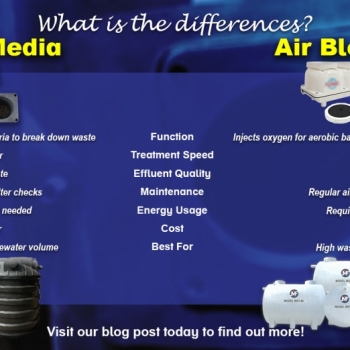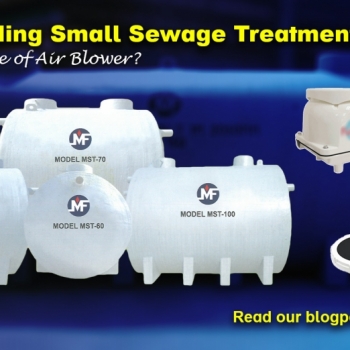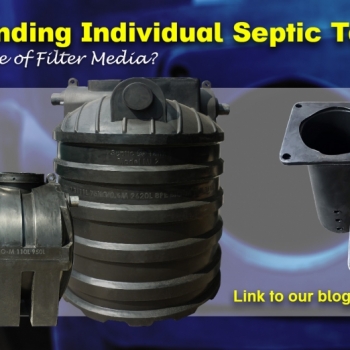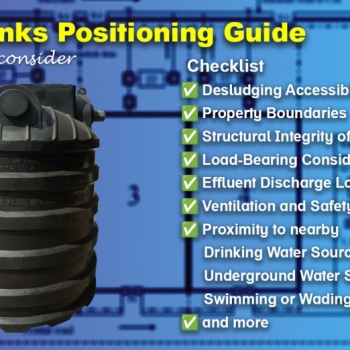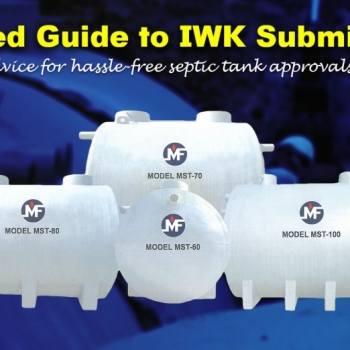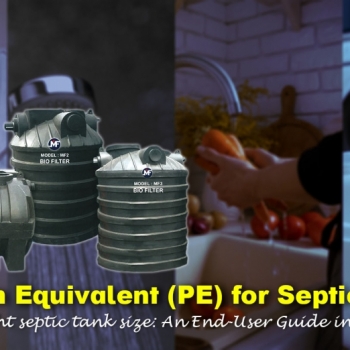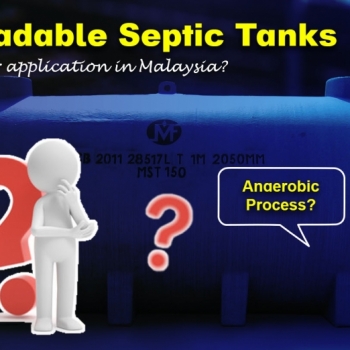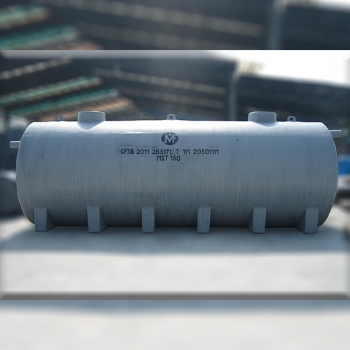Choosing between an individual septic tank with filter media and a mechanical septic tank with an air blower depends on efficiency, cost, and maintenance. This article breaks down their key differences to help you select the right wastewater treatment solution.
Why is Wastewater Treatment Important?
21 Feb 2023

Wastewater Treatment protects humans and the ecosystem from harmful and toxic elements found in wastewater.
Wastewater contains many harmful substances and cannot be released back into the environment until it is treated. It can include contaminants from both residential and commercial use. Untreated, the chemical compounds and pathogens in wastewater can harm the health of flora and fauna live in or near the water. It can also contaminate crops and drinking water, affecting human health. Hence, Wastewater Treatment is fundamental to protect the health of many different ecosystems.
This is where Wastewater Treatment Systems came in and help to purify the water and eliminate situations like what is currently seen in developing countries.
Understanding Sewage Treatment Systems
 Various methods of sewage treatment systems have been developed over the last fifty years to meet the need to protect public health and the environment. For urban centres where the population is concentrated and the receiving environment is not able to cope with the waste discharge, sophisticated treatment systems have evolved, which produces a high quality effluent. Simpler systems have been used to service small communities although ever increasing environment standards means that even these areas must eventually install better treatment systems.
Various methods of sewage treatment systems have been developed over the last fifty years to meet the need to protect public health and the environment. For urban centres where the population is concentrated and the receiving environment is not able to cope with the waste discharge, sophisticated treatment systems have evolved, which produces a high quality effluent. Simpler systems have been used to service small communities although ever increasing environment standards means that even these areas must eventually install better treatment systems.
There are two main types of systems in Malaysia. The most common is the connected sewerage system, while the other is Individual Septic Tanks or Communal Septic Tanks. Other than that, there are more traditional systems such as pour flush and latrines, which are mainly found in rural areas.
Sewage Treatment Objectives
 As population increases by leaps and bounds, it places more pressure on the environment and impacts the sources of fresh water supplies. There was a growing recognition for proper management of human waste.
As population increases by leaps and bounds, it places more pressure on the environment and impacts the sources of fresh water supplies. There was a growing recognition for proper management of human waste.
From the early 1900s there has been a steady evolution of sewage treatment, leading to the modern sewage treatment plants that are capable of producing high quality effluent, which can be safely discharged to the environment or reused.
More recent developments in sewage treatment have been the improvement of reliability and efficiency of treatment systems to meet the standards stipulated and reduce the land area occupied by treatment works through accelerating natural treatment rates under controlled conditions.
However, despite these developments, sewage treatment systems are still mainly concerned with the removal of suspended and floatable materials, the treatment of biodegradable organic and in some cases the elimination of pathogenic organisms.
Individual Septic Tanks (IST) 101
 An IST comprises two chambers connected in a series. In the first chamber, solids from the incoming sewage settle forming a “sludge”, while grease and oil float to the surface forming a “scum” layer. Effluent from between the scum and sludge layers then passes into the second chamber where further sedimentation occurs. Finally, the effluent leaves the second chamber and is discharged into a drain or allowed to percolate into the soil.
An IST comprises two chambers connected in a series. In the first chamber, solids from the incoming sewage settle forming a “sludge”, while grease and oil float to the surface forming a “scum” layer. Effluent from between the scum and sludge layers then passes into the second chamber where further sedimentation occurs. Finally, the effluent leaves the second chamber and is discharged into a drain or allowed to percolate into the soil.
The sludge in the tank undergoes anaerobic digestion and is converted into more stable organic compounds and gases such as carbon dioxide (CO2), methane (CH4) and hydrogen sulfide (H2S). ISTs are usually designed for a 24-hour retention time. Enough storage capacity is provided so that scum and sludge can be deposited in the tank for up to two (2) years after which it must be desludged to keep the tank operating satisfactorily.
ISTs are suitable for single dwellings or individual buildings with a population equivalent (PE) up to 150 and installed where there is no central sewerage systems and where effluent discharges will not adversely affect the environment. It is a cheap solution to disposing of sewage. However, ISTs only partially treat sewage and concentrated groups of tanks can overload the capacity of the receiving environment creating health and odour problems. There are currently over one million ISTs in Malaysia, making it by far the most common type of sewage treatment system.
For inquiries on Individual Septic Tank (IST) or Small Sewage Treatment System (Mechanical Septic Tank (MST)), please contact us via WhatsApp or email to sales@muifatt.com.my.
References
Indah Water Portal | Objective and Systems (iwk.com.my)
Indah Water Portal | IST and Connected (iwk.com.my)
Disclaimer:-
The information provided on this website is for general informational purposes only and does not constitute legal advice. While we strive to ensure the accuracy and reliability of the information provided, we make no representations or warranties of any kind, express or implied, about the completeness, accuracy, reliability, suitability, or availability concerning the information contained herein. Any reliance you place on such information is therefore strictly at your own risk. This website may contain links to other third-party websites. Such links are only for the convenience of the reader, user, or browser; which we do not warrant, recommend, endorse, or assume liability for the contents of the third-party sites.
Keep in touch with us should you be keen on receiving timely updates from us
- Website - https://www.muifatt.com.my/home/
- Facebook - https://www.facebook.com/muifattmarketing
- Instagram - https://www.instagram.com/muifattmarketing/
- Google - https://goo.gl/maps/WxVY13gNcaRTS7Jp6
- Youtube - http://www.youtube.com/@MuiFattMarketing
- TikTok - https://www.tiktok.com/@muifattmarketing
- LinkedIn - https://www.linkedin.com/company/mui-fatt-marketing-sdn-bhd-
- Linktree - https://linktr.ee/muifattmarketing
- Shopee - https://www.shopee.com.my/muifattmarketing
- Lazada - https://www.lazada.com.my/shop/mui-fatt-marketing
Recent Blog
The Role of Air Blower in Mechanical Septic Tanks
Unlike traditional septic systems, mechanical septic tanks use air blowers to accelerate wastewater treatment. This article explores how air blowers enhance aeration, promote bacterial breakdown, and ensure a more effective sewage treatment system in Malaysia.
The Role of Filter Media in Individual Septic Tanks
Filter media plays a critical role in solid-liquid separation and biological treatment in individual septic tanks. This article explores the importance, types, and benefits of filter media in wastewater treatment, helping you make an informed decision when selecting a septic system in Malaysia.
Where Should You Place Your Septic Tank? Key Factors to Consider
Proper septic tank placement is crucial for efficient wastewater treatment. Learn why septic tanks should not be placed inside a house, how their location impacts wastewater disposal, and how to determine the best site for installation.
Simplified IWK Submission Process for Septic Tank Approvals in Malaysia
Navigating the IWK submission process can be challenging. Discover our simplified steps and professional advice for hassle-free septic tank approvals.
Understanding Population Equivalent (PE) for Septic Tanks: An End-User Guide
Discover what Population Equivalent (PE) is and its importance for septic systems, with an easy-to-follow guide for end-users, potential issues of choosing the wrong capacity, and expert tips from Mui Fatt.
Understanding Biodegradable Septic Tanks: A Guide in Malaysia
This article explores biodegradable septic tanks, covering their materials, operations, costs, and maintenance. It also explains why they're rare in Malaysia and introduces alternative sustainable options.
Why Desludging Your Septic Tank Every 2 Years Matters
Regular septic tank desludging ensures efficiency, prevents costly repairs, and protects your environment. Learn the top 10 reasons why this process is critical every two years.



